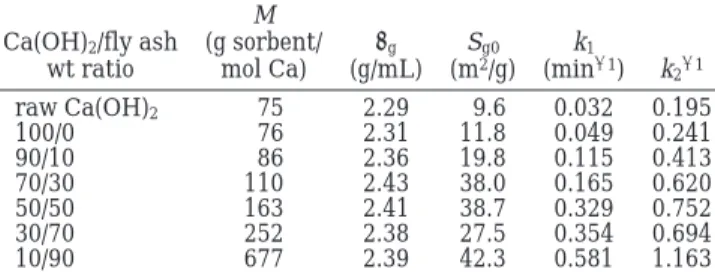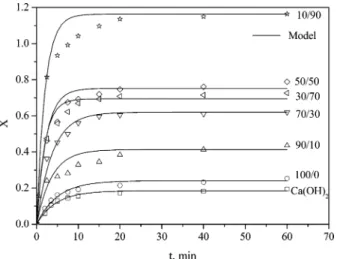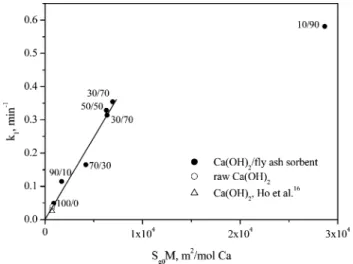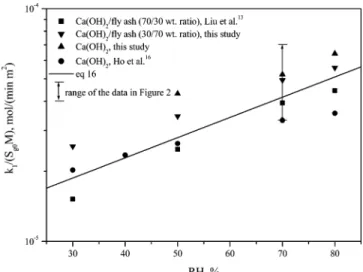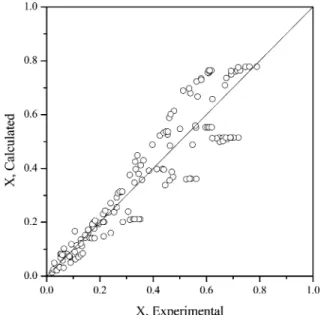Subscriber access provided by NATIONAL TAIWAN UNIV
Industrial & Engineering Chemistry Research is published by the American Chemical Society. 1155 Sixteenth Street N.W., Washington, DC 20036
Article
Kinetic Model for the Reaction of Ca(OH)
2/Fly
Ash Sorbents with SO
2at Low Temperatures
Chiung-Fang Liu, Shin-Min Shih, and Ren-Bin Lin
Ind. Eng. Chem. Res., 2004, 43 (15), 4112-4117 • DOI: 10.1021/ie030840x
Downloaded from http://pubs.acs.org on November 24, 2008
More About This Article
Additional resources and features associated with this article are available within the HTML version: • Supporting Information
• Links to the 2 articles that cite this article, as of the time of this article download • Access to high resolution figures
• Links to articles and content related to this article
Kinetic Model for the Reaction of Ca(OH)
2/Fly Ash Sorbents with
SO
2at Low Temperatures
Chiung-Fang Liu, Shin-Min Shih,* and Ren-Bin Lin
Department of Chemical Engineering, National Taiwan University, Taipei 106, Taiwan
Sorbents prepared with different Ca(OH)2/fly ash weight ratios were reacted with SO2 under conditions similar to those in the bag filters in the spray-drying flue gas desulfurization system. The reaction kinetics was well described by a generalized surface coverage model developed in this study. The model assumes that the sorbent was made up of plate grains and the rate was controlled by the chemical reaction on the grain surface and takes into account the variation in sorbent Ca molar content (M-1) and the surface coverage byproducts. The effect of Ca(OH)2/fly ash weight ratio on the reaction was represented by the effects of the initial specific surface area (Sg0) and M-1of the sorbent on the kinetic parameters. Under the same reaction conditions, the sorbents with weight ratios g 30/70 had about the same initial reaction rate per unit surface area of the sorbent; their ultimate conversions increased linearly with increasing Sg0, being independent of M-1. The effects of relative humidity, SO2 concentration, and temperature on the reaction were unaffected by the Ca(OH)2/fly ash ratio. The results of this study are useful to the design and operation of the dry and semidry processes using Ca(OH)2/fly ash sorbents to remove SO2 from the flue gas.
Introduction
Abatement of SO2 emission from power plants is important for environmental protection. Many flue gas desulfurization (FGD) processes are available for the reduction of SO2 emission. The dry and semidry FGD processes have the advantages of lower capital cost and easier waste treatment in comparison with the wet processes commonly adopted in power plants; however, the conversion of the sorbent, which is mostly hydrated lime [Ca(OH)2], in the dry and semidry processes is low. Many researchers have shown that sorbents prepared from hydrated lime and fly ash have higher SO2 cap-tures and Ca utilizations than hydrated lime alone has.1-14The sorbents were prepared by slurrying hy-drated lime and fly ash in water for a certain period of time and drying the slurry subsequently. Fly ash is the solid waste generated by coal-fired power plants. Thus, the successful use of this kind of sorbent can reduce not only the cost of sorbent but also the cost of waste treat-ment for coal-fired power plants. The structural proper-ties and the reactiviproper-ties toward SO2for Ca(OH)2/fly ash sorbents have been reported to be affected by sorbent preparation conditions, such as the type of fly ash, Ca-(OH)2/fly ash weight ratio, water/solid ratio, the type of additive, hydration temperature, and hydration time. The literature on the kinetic model for the reaction of Ca(OH)2/fly ash sorbents with SO2, however, is scarce. Garea et al.11studied the sulfation of such sorbents (1/3 weight ratio) and proposed a kinetic model based on the nonideal surface adsorption model.15 Recently, we re-ported a surface coverage model for sorbents prepared with a weight ratio of 70/30.13
In this work, the effect of Ca(OH)2/fly ash weight ratio on the kinetics of the reaction of Ca(OH)2/fly ash sorbents with SO2 was investigated, with the aim to develop a kinetic model for sorbents prepared with different weight ratios.
Experimental Section
The Ca(OH)2 reagent, fly ash, sorbent preparation procedure, and experimental setup and procedure for sulfation experiments used in this work were the same as those described in Liu et al.13 and Lin et al.14 Sorbents with different Ca(OH)2/fly ash weight ratios, as those listed in Table 1, were prepared at a water/ solid weight ratio of 10/1, a slurrying temperature of 65 °C, and a slurrying time of 16 h. The sorbents were reacted with SO2mainly under the conditions of 60 °C, 70% relative humidity (RH), and 1000 ppm SO2.
The conversion, X, of a reacted sample was defined as its SO32-/Ca2+molar ratio. The SO32-content in a sample was determined by iodometric titration, and the Ca2+content by EDTA titration. For each Ca(OH)
2/fly ash weight ratio, the Ca2+molar content in the sorbent was determined by EDTA titration, and its reciprocal, M, the initial sorbent weight per mole of Ca, is listed in Table 1. The M value increases as the Ca(OH)2/fly ash weight ratio decreases.
The characterization of the Ca(OH)2/fly ash sorbents has been reported in our recent work.14 The sorbents contained calcium silicate hydrates, which were formed during the sample preparation period. The amounts of * To whom correspondence should be addressed. Tel:
886-2-23633974. Fax: 886-2-23623040. E-mail: smshih@ ccms.ntu.edu.tw.
Table 1. Ca(OH)2/Fly Ash Weight Ratios, Sorbent Weights per Mole of Ca, True Densities, BET Specific Surface Areas, and Values of k1and k2-1in eq 1 for Ca(OH)2/Fly Ash Sorbentsa
Ca(OH)2/fly ash
wt ratio M (g sorbent/ mol Ca) Fg (g/mL) Sg0 (m2/g) k1 (min-1) k2-1 raw Ca(OH)2 75 2.29 9.6 0.032 0.195 100/0 76 2.31 11.8 0.049 0.241 90/10 86 2.36 19.8 0.115 0.413 70/30 110 2.43 38.0 0.165 0.620 50/50 163 2.41 38.7 0.329 0.752 30/70 252 2.38 27.5 0.354 0.694 10/90 677 2.39 42.3 0.581 1.163
aSlurrying conditions: 65 °C, L/S ) 10/1, and 16 h. Reaction
conditions: 60 °C, 70% RH, and 1000 ppm SO2.
10.1021/ie030840x CCC: $27.50 © 2004 American Chemical Society Published on Web 06/26/2004
calcium silicate hydrates in sorbents with 70/30 to 30/ 70 ratios were more than those in sorbents with 90/10 and 10/90 ratios. The mean particle diameters of the sorbents with 70/30 to 10/90 ratios were in the range of 9-35 µm, and those of raw Ca(OH)2, slurried Ca(OH)2, and the sorbents with a 90/10 ratio were in the range of 4-7 µm. All the Ca(OH)2/fly ash sorbents were mesoporous materials; their specific surface areas and pore volumes were larger than those of Ca(OH)2or fly ash alone. The BET specific surface area, Sg0, of each sorbent is listed in Table 1.
Results and Discussion
Effect of Sorbent Ca(OH)2/Fly Ash Ratio on the
Reaction. The experimental results for the reaction of the sorbents with SO2are shown in Figure 1 in terms of conversion X versus time t. As shown in Figure 1, the sorbent reactivity increases with decreasing Ca-(OH)2/fly ash ratio except the sorbents with ratios of 50/ 50 and 30/70; the latter sorbent is slightly less reactive than the former. The reaction of each sorbent is seen to stop at an ultimate conversion after about a 20 min reaction time. The ultimate conversion of the sorbent with a ratio of 10/90 exceeds unity; this is because the contribution of the reactive compounds of Na, K, and Mg other than Ca present in the fly ash particles was also included in the calculation of conversion.
Kinetic Model. The foregoing results show that all the sorbents have similar reaction behavior that the reaction is fast in the initial stage and then levels off abruptly. Among the sorbents, Ca(OH)216,17and the Ca-(OH)2/fly ash sorbent with a ratio of 70/3013have been subjected to extensive kinetic studies, and their reaction kinetics have been found to be well described by the surface coverage model proposed by Shih et al.18
The hypotheses of the surface coverage model are that the sorbent is made up of plate grains and that the reaction rate is controlled by chemical reaction on the surface of a grain and the reacting surface area of the grain decreases with the deposition of solid products. According to this model, the reaction of a sorbent reaches an ultimate conversion when its reacting sur-face is fully covered by the products.
The surface coverage model proposed in the previous studies13,16-18is for the sorbents which have the same
Ca molar content. The model can be generalized to describe the reaction of the sorbents which have differ-ent Ca molar contdiffer-ents.
The reaction rate of a sorbent per unit initial surface area, rS, can be expressed as
where ksis a function of temperature, concentrations of reacting gas species, and relative humidity; M-1is the Ca molar content in the sorbent and the index a represents the effect of Ca content on the sorbent reactivity; and Φ is the fraction of the surface area which is not covered byproducts. The rate of conversion of the sorbent is
where Sg0 is the initial specific surface area of the sorbent.
The change of Φ with reaction time depends on the reaction rate, the content of Ca, and the way by which the products deposit on the surface. The effect of Ca content on Φ can be seen from Figure 1. Figure 1 shows that the sorbent has a higher initial rate of conversion when its Ca(OH)2/fly ash ratio is lower (that is, its M value is larger), but it reaches the ultimate conversion no later. This fact indicates that the rate of change of Φ increased with increasing M. Thus, one may assume that
where kPis a proportional constant, which may be also a function of temperature, concentrations of reacting gas species, and relative humidity, and b is an index representing the effect of M. If ksand kpdo not vary with time, eq 3 can be integrated to get
where
By substitution of eq 4 into eq 2, one can integrate eq 2 to obtain the relation between conversion and time
From eq 7 one can see that the ultimate conversion is equal to k2-1. From the differential form of eq 7
it is obvious that the initial rate of conversion is equal to k1.
In the previous studies,13,16-18the same equation as eq 7 was obtained for X as a function of t, but the k1 and k2equations were defined as the case that a and b in eqs 5 and 6 equal zero.
The two parameters, k1and k2, in eq 7 can be obtained by nonlinear least-squares fitting of the equation to the experimental X versus t data. Table 1 summarizes the
Figure 1. Effect of Ca(OH)2/fly ash weight ratio on the reaction of Ca(OH)2/fly ash sorbents with SO2. Slurrying conditions: 65 °C, L/S ) 10/1, and 16 h. Reaction conditions: 60 °C, 70% RH, and 1000 ppm SO2. rs) kSM -a Φ (1) dX/dt ) Sg0MrS) Sg0ksM1-aΦ (2) -dΦ/dt ) kPksM b Φ (3) Φ ) exp(-k1k2t) (4) k1) kSSg0M 1-a (5) k2) kPMa+b-1/Sg0 (6) X ) [1 - exp(-k1k2t)]/k2 (7) dX/dt ) k1(1 - k2X) (8)
values of k1and k2-1thus obtained. The curves plotted in Figure 1 using eq 7 show that the experimental data are well described by eq 7.
Effect of Ca(OH)2/Fly Ash Ratio on k1 and k2. From Table 1, one can see that the values of k1and k2-1 vary from sorbent to sorbent, indicating that they are affected by the Ca(OH)2/fly ash weight ratio. However, eqs 5 and 6 predict that the effect of the Ca(OH)2/fly ash weight ratio on the values of k1and k2-1is entirely represented by the effects of Sg0and M. These correla-tions can be confirmed and the parameters a and b in the equations can be determined using the data of k1,
k2, Sg0, and M. In the following analysis, the data listed in Table 1 and those listed in Table 2 for another batch of Ca(OH)2and another batch of the sorbent with a Ca-(OH)2/fly ash ratio of 30/70 are taken into consideration. The data given by Ho et al.16for Ca(OH)
2(M ) 74 g/mol,
Sg0) 10.0 m2/g) are also included.
The k1 value for each sorbent is plotted against its
Sg0M in Figure 2 . Except the data for the sorbent with a 10/90 ratio, k1and Sg0M follow the linear relationship given by eq 5 when a ) 0. The linear least-squares fitting line in Figure 2 gave
with a correlation coefficient of 0.992. The standard error of the slope of the line is also indicated in eq 9. This result indicates that under the same reaction conditions all the sorbents except the one with a 10/90 ratio have about the same kSvalue or the same initial rate per unit surface area of the sorbent according to eq 1. Moreover, according to eqs 8 and 9, the initial
rate of conversion for a sorbent is proportional to its Sg0 and M.
As shown in Figure 3, there is a linear relationship between k2-1 and Sg0, except the data for the sorbent with 10/90 ratio. The linear least-squares fitting line in Figure 3 gave
with a correlation coefficient of 0.946. This result indicates that k2is independent of M. Thus, b in eq 6 must be unity because a in eq 5 has been found to be zero.
According to eq 7, k2-1equals the ultimate conversion. Therefore, eq 10 implies that the ultimate conversion of a sorbent is proportional to its Sg0and independent of its M.
The reason that the k1or k2-1value for the sorbent with a 10/90 ratio could not be predicted by eq 9 or 10 is thought to be due to the excess of the fly ash content; this sorbent contained much more reactive constituents other than Ca(OH)2and calcium silicate hydrates than the sorbents with ratios g 30/70.
Discussion on Ultimate Conversion. For a sorbent made up of plate grains, the conversion of the sorbent can be expressed as19
where r0 is the initial half-thickness of the plate and ∆r is the thickness of the outer layer of the original grain that has been reacted. r0can be estimated by
where Fgis the true density of the sorbent. Combining eqs 11 and 12 gives
When the reaction stops due to the complete coverage of the reactive surface, X and ∆r reach the maximum values, Xmand ∆rm, and
Figure 2. Plot of k1versus Sg0M. Slurrying conditions: 65 °C, L/S ) 10/1, 16 h. Reaction conditions: 60 °C, 70% RH, and 1000 ppm SO2.
Table 2. Values of k1and k2-1for Ca(OH)2(M ) 74 g/mol
Ca, Sg0) 10.3 m2/g) and the Sorbent with a Ca(OH)2/Fly
Ash Weight Ratio of 30/70 (M ) 248 g/mol Ca, Sg0) 25.6
m2/g) Reacted with SO 2 sorbent T (K) RH (%) y (ppm) k1(min-1) k2-1 Ca(OH)2 333 50 1000 0.033 0.140 333 70 1000 0.040 0.186 333 80 1000 0.049 0.255
Ca(OH)2/fly ash 333 30 1000 0.163 0.330
333 50 1000 0.220 0.527 333 70 1000 0.314 0.672 333 80 1000 0.355 0.787 333 70 5000 0.435 0.694 353 70 1000 0.466 0.694 k1(min -1 ) ) [(5.00 ( 0.23)× 10-5]Sg0M (9)
Figure 3. Plot of k2-1versus Sg0. Slurrying conditions: 65 °C, L/S ) 10/1, 16 h. Reaction conditions: 60 °C, 70% RH, and 1000 ppm SO2. k2-1) [(2.04 ( 0.12) × 10-2]Sg0 (10) X )∆r r0 (11) r0) 1 F gSg0 (12) X ) FgSg0∆r (13) Xm) FgSg0∆rm (14)
Comparing eqs 6 and 14 gives
Thus, the inverse of kpMa+b-1can be interpreted as the maximum weight reacted per unit surface area of the sorbent.
According to eq 14, Xmis proportional to Sg0alone only when Fg∆rmis constant. Thus, the linear relationship between Xmand Sg0represented by eq 10 implies that Fg∆rmfor each sorbent must be about the same. Fur-thermore, the Fg’s of the sorbents, as shown in Table 1, are about the same, being in the range of 2.29 to 2.43 g/cm3. Therefore, ∆r
m, the maximum thickness of the reacted layer, must be about the same for each sorbent also.
Effects of Reaction Conditions on k1 and k2. Equations 9 and 10 were obtained under the reactions of 60 °C, 70% RH, and 1000 ppm SO2. According to Ho et al.16and Liu et al.,13k
1and k2are also functions of RH, temperature, and SO2concentration, but only RH affects k1 and k2significantly.
To know whether the relationship between k1 or k2 and Sg0and M is affected by the RH and whether the relationship between k1or k2and RH is affected by the Ca(OH)2/fly ash weight ratio, samples of Ca(OH)2(M ) 74 g/mol Ca, Sg0)10.3 m2/g) and the sorbent with a ratio of 30/70 (M ) 248 g/mol Ca, Sg0 ) 25.6 m2/g) were reacted with 1000 ppm of SO2 at 60 °C and different RHs (30-80% RH). The results for the latter sorbent are shown in Figure 4, indicating that the RH indeed enhances the reaction significantly. The latter sorbent was also reacted at a higher SO2 concentration(5000 ppm) and a higher temperature(80 °C). The X vs t results, not shown here, indicated that the increase in SO2concentration or temperature increased only mildly the initial rate of conversion, having a negligible effect on the ultimate conversion.
The k1 and k2 values obtained for the foregoing reactions, as shown in Table 2, are compared with those already reported for Ca(OH)216and the Ca(OH)2/fly ash sorbent with a 70/30 ratio13 in terms of ln[k
1/(Sg0M)] versus RH in Figure 5 and ln[k2-1/Sg0] versus ln RH in Figure 6 . According to the correlations given by Liu et al.,13these plots are linear for the sorbent with a 70/30 ratio. As can be seen in Figures 5 and 6, the data for each sorbent seem to exhibit a linear trend in general.
For k1/(Sg0M) (Figure 5), the range of the data at each RH is smaller than that for the data considered in Figure 2 (70% RH); however, for k2-1/Sg0(Figure 6), the range of the data at 80% RH is greater than that for the data considered in Figure 3 (70% RH). These results indicate that the linear relationship between k1 and
Sg0M or between k2-1and Sg0is as good as that at 70% RH for RH e 70% and that the relationship between k1 or k2 and RH is nearly unaffected by the Ca(OH)2/fly ash ratio.
The equations representing the effects of RH (30-70% RH), temperature (T, 333-353 K), and SO2 con-centration (y, 1000-5000 ppm) on k1 and k2 for the sorbents with weight ratios g 30/70 were further derived and the parameters in the equations were determined by multiple regression,16 using the data shown in Tables 1 and 2, Figures 5 and 6, and those at 70% RH, 70 and 80 °C, and 3000 and 5000 ppm SO2 given in the article by Liu et al.13The resulting k
1and
k2-1equations are
The 95% confidence intervals for the parameters in the above equations are (2.15 × 10-4)e(5.76 min-1,
Figure 4. Effect of the RH on the reaction of Ca(OH)2/fly ash (30/70 wt ratio, M ) 248 g/mol Ca) sorbent. Slurrying conditions: 65 °C, L/S ) 10/1, and 16 h. Reaction conditions: 60 °C and 1000 ppm SO2.
(kpMa+b-1)-1) Fg∆rm (15)
Figure 5. Relationship between k1and relative humidity for sorbents. Other reaction conditions: 60 °C and 1000 ppm SO2.
Figure 6. Relationship between k2and relative humidity for sorbents. Other reaction conditions: 60 °C and 1000 ppm SO2.
k1(min -1 ) ) (2.15× 10-4)Sg0Me 0.022RH y0.10e-10000/RT (16) k2-1) (2.33 × 10-4)Sg0RH1.05 (17) Ind. Eng. Chem. Res., Vol. 43, No. 15, 2004 4115
0.022 ( 0.007, 0.10 ( 0.20, and -10000 ( 16000 J/mol, respectively, for eq 16, and (2.33× 10-4)e(3.19and 1.05 ( 0.78 for eq 17. The standard deviations of k1and k2-1 from the values calculated by eqs 16 and 17 are 0.04 min-1 and 0.12, respectively. The lines plotted in Figures 5 and 6 show the agreement of eqs 16 and 17 with the data.
In Figure 7, conversions calculated by eq 7 together with eqs 16 and 17 are compared with the experimental results obtained for the sorbents and reaction conditions mentioned in the above paragraph. The comparison shows that both conversions are in agreement with a standard deviation of 0.09. This agreement is considered to be satisfactory for the Ca(OH)2/fly ash sorbents, which have complex sorbent compositions and reaction behaviors.
The rate-controlling step for the reaction of sorbents is thought to be the dissolution of the Ca-containing solid reactants proceeding through the reaction with the acid formed by the SO2 and H2O molecules adsorbed on the sorbent surface. Raising the RH increases the amount of water adsorbed and hence the amount of acid formed and the amount of solid reactants dissolved. A greater amount of adsorbed water also provides a wider range for the product molecules to deposit and thus would result in a lower rate of covering the reaction surface.13,16,17 Therefore, the RH showed a significant effect on the reaction rate and the ultimate conversion. The amount of SO2 molecules dissolved in the water layer may be limited by the amount of the adsorbed water; thus, the reaction would be insensitive to the gas-phase SO2concentration. The mild effect of temperature on the reaction rate may be due to the fact that as the temperature increases, the chemical reaction rate con-stants increase, whereas the amounts of water and SO2 adsorbed decrease. Although the amount of water adsorbed decreased with increasing temperature, the thickness of the water layer was mainly function of RH and nearly independent of temperature, according to the measurements by Liu et al.13This may be the reason that the ultimate conversion was mainly affected by the RH.
When the reaction conditions vary with time, like the case encountered in industrial FGD processes, the
differential form of the model can be used. Substituting eqs 5 and 6 into eqs 2 and 3 gives
Substituting eqs 16 and 17 into eqs 18 and 19, the latter two equations can be integrated to obtain X if the variations of reaction conditions with time are known. Conclusion
From the above analyses, we can conclude that for a Ca(OH)2/fly ash sorbent prepared with a weight ratio g 30/70, its reaction with SO2at low temperatures can well be described by the generalized surface coverage model developed in this study. The model assumes that the sorbent was made up of plate grains and the rate was controlled by the chemical reaction on the grain surface and takes into account the variation in sorbent Ca molar content (M-1) and the surface coverage byproducts. The effect of Ca(OH)2/fly ash weight ratio on the reaction kinetics was represented by the effects of the Sg0and M of the sorbent on the kinetic param-eters. Under the same reaction conditions, the sorbents with weight ratios g 30/70, including Ca(OH)2 alone, had about the same initial rate per unit surface area of the sorbent and their ultimate conversions, being inde-pendent of the M value, increased linearly with increas-ing Sg0. The effects of relative humidity, SO2 concen-tration, and temperature on the reaction were unaffected by the Ca(OH)2/fly ash ratio. The initial conversion rate and ultimate conversion of a sorbent increased signifi-cantly with increasing relative humidity. Temperature and SO2 concentration had mild effects on the initial conversion rate and negligible effects on the ultimate conversion. The results of this study are useful to the design and operation of the dry and semidry processes using Ca(OH)2/fly ash sorbents to remove SO2from the flue gas.
Acknowledgment
This research was supported by the National Science Council of Republic of China, Taiwan.
Nomenclature
a ) index of M-1in eq 1, dimensionless
b ) index of M in eq 3, dimensionless
kP) constant defined by eq 3, m2mola+b-1/ga+b
kS) constant defined by eq 1, gamol1-a/(min m2)
k1) kSSg0M1-a, min-1
k2) kPMa+b-1/Sg0, dimensionless
M ) initial weight of solid per mol of Ca, g/mol R ) gas constant, 8.314 J/mol K
RH ) relative humidity, %
r0) initial half-thickness of a plate grain, m
rS) reaction rate of solid, mol/(min m2)
∆r ) thickness of reacted layer of a grain, m ∆rm) the maximum value of ∆r, m
Sg0) initial specific surface area of solid, m2/g
T ) reaction temperature, K t ) time, min
X ) conversion, dimensionless
Xm) the maximum value of X, dimensionless
y ) SO2concentration, ppm Figure 7. Comparison of the calculated and experimental
conver-sion values.
dX/dt ) k1Φ (18)
Greek Symbols
Fg) true density of sorbent, g/mL Literature Cited
(1) Jozewicz, W.; Rochelle, G. T. Fly ash recycle in dry scrub-bing. Environ. Prog. 1986, 5, 219-224.
(2) Ho, C. S. Reaction of Ca(OH)2and fly ash/Ca(OH)2slurry
with SO2. MS. Engr. Thesis, Department of Chemical Engineering,
National Taiwan University, Taipei, Taiwan, R. O. C., 1987. (3) Jozewicz, W.; Jorgensen, C.; Chang, J. C. S.; Sedman, C. B.; Brna, T. Development and pilot plant evaluation of silica-enhanced lime sorbents for dry flue gas desulfurization. J. Air Pollut. Control Assoc. 1988, 38, 796-805.
(4) Jozewicz, W.; Chang, J. C. S.; Sedman, C. B.; Brna, T. Silica-enhanced sorbents for dry injection removal of SO2from flue gas.
J. Air Pollut. Control Assoc. 1988, 38, 1027-1034.
(5) Martinez, J. C.; Izquierdo, J. F.; Cunill, F.; Tejero, J.; Querol, J. Reactivation of fly ash and Ca(OH)2mixtures for SO2removal
of flue gas. Ind. Eng. Chem. Res. 1991, 30, 2143-2147.
(6) Ho, C. S.; Shih, S. M. Ca(OH)2/fly ash sorbents for SO2
removal. Ind. Eng. Chem. Res. 1992, 31, 1130-1135.
(7) Ho, C. S.; Shih, S. M. Characteristic and SO2 capture
capacities of sorbents prepared from products of spray-drying flue gas desulfurization. Can. J. Chem. Eng. 1993, 71, 934-939.
(8) Davini, P. Investigation of flue gas desulfurization by fly ash and calcium hydroxide mixtures. Resour. Conserv. Recycl.
1995, 15, 193-202.
(9) Sanders, J. R.; Keener, T. C.; Wang, J. Heated fly ash/ hydrated lime slurries for SO2removal in spray dryer absorbers.
Ind. Eng. Chem. Res. 1995, 34, 302-307.
(10) Garea, A.; Fernandez, J.; Viguri, J. R.; Ortiz, M. I., Renedo; M. J.; Irabien, A. Fly ash/calcium hydroxide mixtures for SO2
removal: structural properties and maximum Yield. Chem. Eng. J. 1997, 66, 171-179.
(11) Garea, A.; Viguri, J. R.; Irabien, A. Kinetics of the flue gas desulfurization at low temperature: fly ash/calcium (3/1) sorbent behavior. Chem. Eng. Sci. 1997, 52, 715-732.
(12) Ishizuka, T.; Tsuchiai, H.; Murayama, T.; Tanaka, T.; Hattori, H. Preparation of active absorbent for dry-type flue gas desulfurization from calcium oxide, coal fly ash, and gypsum. Ind. Eng. Chem. Res. 2000, 39, 1390-1396.
(13) Liu, C. F.; Shih, S. M.; Lin, R. B. Kinetics of the reaction of Ca(OH)2/fly ash sorbent with SO2at low temperatures. Chem.
Eng. Sci. 2002, 57, 93-104.
(14) Lin, R. B.; Shih, S. M.; Liu, C. F. Structural properties and reactivities of Ca(OH)2/fly ash sorbents for flue gas
desulfu-rization. Ind. Eng. Chem. Res. 2003, 42, 1350-1356.
(15) Irabien, A.; Cortabitarte, F.; Ortiz, M. I. Kinetics of flue gas desulfurization at low temperature: nonideal surface adsorp-tion model. Chem. Eng. Sci. 1992, 47, 1533-1543.
(16) Ho, C. S.; Shih, S. M.; Liu, C. F.; Chu. H. M.; Lee, C. D. Kinetics of the sulfation of Ca(OH)2at low temperatures. Ind. Eng.
Chem. Res. 2002, 41, 3357-3364.
(17) Liu, C. F.; Shih, S. M. A surface coverage model for the reaction of Ca(OH)2with SO2at low temperatures. J. Chin. Inst.
Chem. Engrs. 2002, 33, 407-413.
(18) Shih, S. M.; Ho, C. S.; Song, Y. S.; Lin, J. P. Kinetics of the reaction of Ca(OH)2with CO2at low temperature. Ind. Eng.
Chem. Res. 1999, 38, 8, 1316-1322.
(19) Szekely, J.; Evans, J. W.; Sohn, H. Y. Gas-solid reactions; Academic Press: New York, 1976.
Received for review November 21, 2003 Revised manuscript received May 17, 2004 Accepted May 20, 2004 IE030840X
